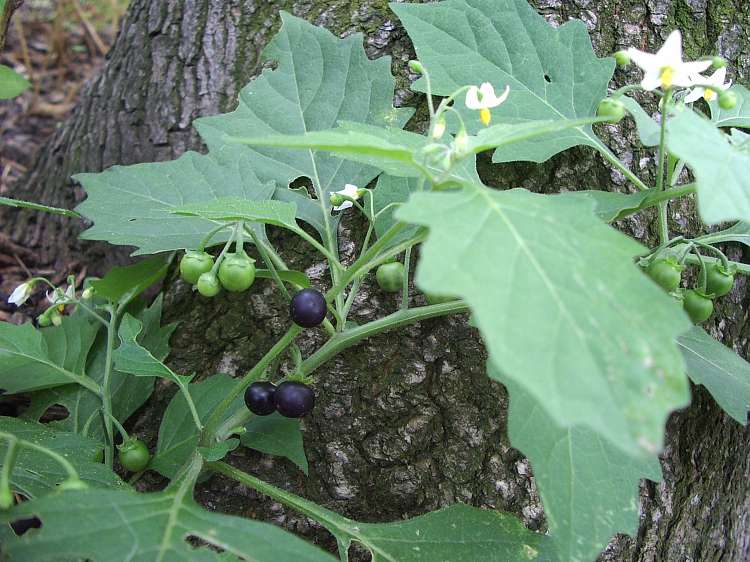Solanum nigrum

|
|
Solanum nigrum Common Names: Black nightshade, wonder berry Scientific
Classification Kingdom: Plantae Clade: Tracheophytes Clade: Angiosperms Order: Solanales Family: Solanaceae Genus: Solanum Species: S. nigrum Binomial Name: Solanum nigrum L. Synonyms: Solanum decipiens Durieu & Noe, Solanum nigrum var. villosum L., Solanum nigrum var. virginicum L. Morphological Description Solanum nigrum,
commonly known as black nightshade, is an herbaceous plant or short-lived
perennial shrub that typically grows to heights of 30–120 cm, though it can
occasionally reach up to 150 cm in favorable conditions (Chen et al., 2022).
The stems are erect to sprawling, green or purplish, and often sparsely
pubescent or glabrous, with angular branching patterns. The leaves are ovate to
heart-shaped, measuring 2.5–10 cm long and 1.5–5.5 cm wide, with wavy or
coarsely toothed margins and a petiole of 1–2 cm (Kew Science, n.d.). Leaf
surfaces vary from hairy to smooth depending on the variety. The plant produces
small, star-shaped flowers, 5–10 mm in diameter, with five white petals and
prominent yellow anthers, arranged in umbel-like clusters of 5–10 blooms (Chen
et al., 2022). The berries are spherical, 6–10 mm in diameter, typically dull
black or purple-black when ripe, though red-berried forms exist in some
regions, such as parts of India and South Africa (Kaunda & Zhang, 2019).
These berries grow in drooping clusters and contain numerous small, flattened
seeds, often mistaken for the solitary, glossy berries of the more toxic Atropa belladonna. Distribution and Habitat Solanum nigrum is
native to Eurasia but has become naturalized across temperate and tropical
regions of Europe, Asia, Africa, Australia, and the Americas due to its
adaptability and anthropogenic dispersal (Chen et al., 2022). It thrives in
disturbed environments such as roadsides, gardens, agricultural fields, and
wastelands, often acting as a pioneer species in degraded soils (Kew Science,
n.d.). The plant prefers well-drained soils rich in organic matter, with an
optimal pH range of 5.5–6.5, though it can tolerate a broader range from 4.5 to
8.0 (Kaunda & Zhang, 2019). It grows at altitudes from sea level up to
2,500 meters and flourishes in climates with annual rainfall of 500–1,200 mm
and temperatures between 15–30°C (Useful Tropical Plants, n.d.). Ethnopharmacology Solanum nigrum has
a rich history in traditional medicine across multiple cultures, attributed to
its diverse bioactive compounds, including steroidal saponins, alkaloids (e.g.,
solanine, solamargine), phenols, and polysaccharides (Chen et al., 2022). Below
are key ethnopharmacological uses supported by research: · Anti-inflammatory and Analgesic: In India, leaf decoctions are used in
Ayurveda to treat inflammatory conditions like arthritis and skin diseases,
balancing the three doshas (IAFA, n.d.). A study showed that ethanol extracts
of the plant reduced carrageenan-induced paw edema in rats by 40%, linked to
flavonoids and steroidal glycosides (Zakaria et al., 2009). · Antitumor Activity: In Traditional Chinese Medicine (TCM), the
whole plant is used to treat cancers, such as cervical and liver carcinomas.
Research confirms that solamargine from S. nigrum induces apoptosis in human cancer cell
lines (e.g., HT-29) by upregulating TNF receptors and mitochondrial pathways
(Chen et al., 2022). · Antibacterial Effects: In Nigeria, leaf infusions treat sore
throats and skin infections. · Neuroprotective and Hepatoprotective: In South Africa, the plant is used as a
liver tonic. Studies demonstrate that polysaccharide fractions protect against
CCl4-induced hepatic damage in rats, reducing ALT levels by 35%
(Balasubramanian et al., 2003). These traditional uses
are supported by its phytochemical profile, with over 188 compounds identified,
including solasonine and glycoproteins with immunomodulatory effects (Chen et
al., 2022). ⚠ Toxicity Profile: Solanum nigrum contains solanine, a glycoalkaloid
concentrated in unripe berries and leaves, which can cause toxicity if ingested
in large amounts (Chen et al., 2022). Symptoms include fever, sweating,
vomiting, abdominal pain, diarrhea, confusion, and drowsiness, with severe
cases potentially leading to cardiac arrhythmias and respiratory failure
(Useful Tropical Plants, n.d.). Cooking reduces solanine levels by up to 50%,
making ripe berries and leaves safe for consumption in moderation in some
cultures (Kaunda & Zhang, 2019). The LD50 in mice is approximately 500
mg/kg for solanine, indicating moderate toxicity (Chen et al., 2022). Additional Uses · Varietal Diversity: The species exhibits high variability,
with subspecies like S. nigrum subsp. schultesii and red-fruited forms used ornamentally or
medicinally (Kew Science, n.d.). · Ecological Role: It serves as a food source for birds and
small mammals, aiding seed dispersal and ecological succession in disturbed
areas (Useful Tropical Plants, n.d.). References
External Links More Pictures |
|
| Compounds of Solanum nigrum |
|
| References |